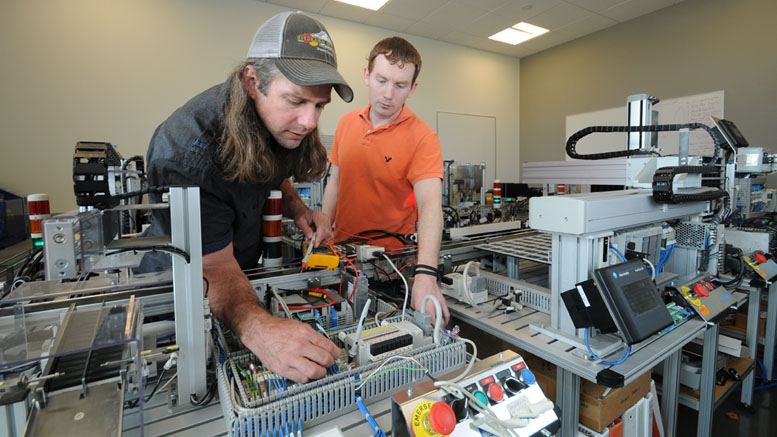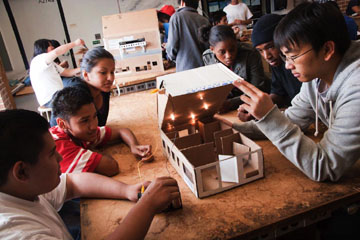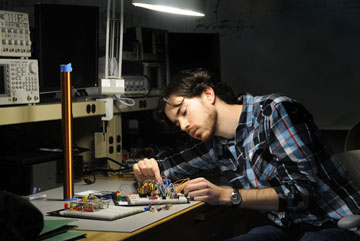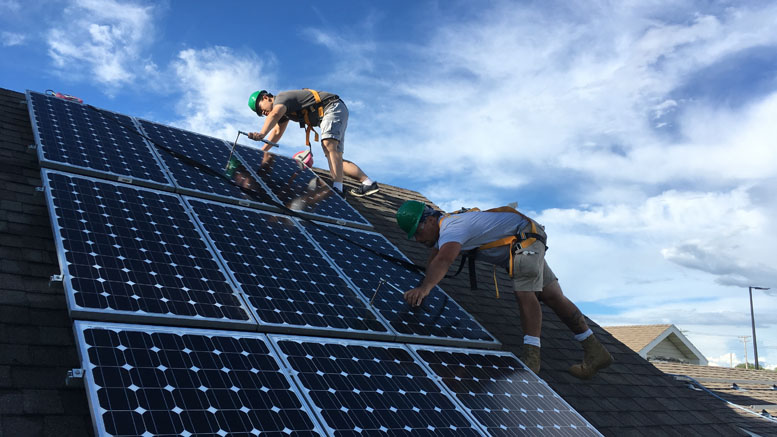Like many community colleges across the nation, Laney College in California developed stand-alone programs in renewable energy after Congress enacted the American Recovery and Reinvestment Act of 2009, which provided funding for those initiatives as part of a massive effort to stimulate the economy after the recession.
“ARRA created the supply, but the demand side wasn’t addressed,” says Peter Crabtree, dean of career and technical education at Laney. Lots of people were trained, but there weren’t enough jobs. As a result the programs weren’t attracting enough students.
Other community colleges across the country were a facing similar situation. But instead of dropping renewable energy, many colleges folded the content into other programs, such as electrical engineering or the construction trades.
Impact of state policy
When Madison Area Technical College (MATC) in Wisconsin introduced a certification program in renewable energy 15 years ago, it was one of the first community colleges to do so and attracted students from other states and even other countries, says instructor Ken Walz.
In the early 2000s, Wisconsin had policies in place to support alternative energy and, as a result, it was among the top 10 states for biofuels, solar and wind energy, Walz says.
“Now, we’re more locally focused,” he says, “and our certification programs are designed to pair with training in a traditional field.”
Companies want civil engineers who know about wind technology, for example, or architects who can design a home that relies on solar or geothermal energy, Walz says. Many of the students he teaches are already on campus working on degrees in science or engineering and want to add renewable energy to their skill sets.
Even large solar or wind installations don’t need a huge permanent workforce, Walz says.
There are about 15 major solar projects under way or being planned in Wisconsin that expect to hire hundreds of workers in the next two years or so, including a 300-megawatt installation from NextEra Energy. But those are temporary construction jobs, Walz says. Solar projects need far fewer employees for operating and maintaining those systems.
Cutbacks in biofuels
MATC developed certifications in biofuels in the early 2000s when dozens of ethanol and biodiesel plants were built in the state, but that sector is now built out and fully staffed, Walz says. The college suspended its biofuels classes about five years ago.
“There’s no demand for that anymore,” he says. “We don’t want to be training students for jobs that don’t exist.”
Walz cites several reasons for the biofuels crash: Those plants need a lot of agricultural waste to produce energy; oil prices have declined; and it’s become dramatically cheaper to produce electricity from solar and wind power than biogas, even in Wisconsin, which isn’t particularly sunny or windy.
MATC’s nine-credit certification program in renewable energy is now focused on solar, because that’s where the jobs are, Walz says. If a wind farm is built nearby, the program could be adjusted.
There are about 64 or 65 students in the program. To earn a certificate, students take a survey course in renewable energy, an introductory course on solar energy and three more credits in a related topic. Most earn an associate degree, too.
Some students already have part-time jobs as electricians or engineers, and some have apprenticeships. Apprentices work four days a week, and their employer, primarily an electrical contractor, pays them to attend MATC one day a week.
Sustainable buildings
At Laney College, all students in electrical technology learn about solar energy, and a course on energy efficiency is part of the core curriculum for students in the residential HVAC program.
“Even in California, we found that was the best way to go,” says Crabtree, noting that the state is ahead of the rest of the nation in adopting policies to encourage renewable energy.
California produces so much solar energy that there’s a surplus around noon, As a result, there’s growing interest in training people for jobs in electrical grid management and photovoltaic battery storage systems.
While Laney doesn’t offer a stand-alone program on solar energy, it does have a test prep course for the North American Board of Certified Energy Practitioners certification exam.

A lab in the electro-mechanical program at Columbia Gorge Community College. (Photo: CGCC)
The markets for renewable energy are highly sensitive to local and state policy,Crabtreee says. For example, Florida, the “sunshine state,” depends heavily on coal to produce energy, and thus has a fraction of the solar installments in less-sunny Massachusetts.
California’s emphases on energy-saving buildings has led Laney to focus on that as well. The state requires all new residential construction to be “zero net energy” by 2020, which means the total amount of energy used is equal to the amount of renewable energy generated. The deadline for new commercial buildings is 2030.
That is creating a growing demand for workers trained to operate building automation systems (BAS), which control the temperature and lighting so energy isn’t wasted when no one’s there. New innovations are continually coming on line, such as censors embedded in windows, so they darken automatically and conduct less thermal radiation.
At Laney, construction-related programs have courses that “get deep into designing homes for efficiency,” Crabtree says, noting that students already built a “zero net” home in East Oakland.

Laney College students work on project to build energy-efficient houses. (Photo: Laney College)
The college offers an associate degree and certificate in BAS, a topic also covered in other programs, such as HVAC. As many as half the students in Laney’s BAS program already have bachelor’s degrees, often in such areas as electrical engineering or energy technology.
BAS technicians need to know information technology, physics, math and thermodynamics, says Crabtree. “It’s a very challenging field, but it’s very lucrative and in really high demand.” Salaries can start at $30 an hour, and with a few years of experience can grow to more than $100,000 a year.
And that has led to one of the biggest challenges, Crabtree says: finding qualified professionals willing to take a pay cut to teach a course. Another challenge is licensing fees for the software that runs BAS, which can cost $2,500 a year. Laney works with the industry to gain access to open-source software, as well as discounts on equipment.
Laney’s BEST Center (Building Efficiency for a Sustainable Tomorrow), supported by the National Science Foundation (NSF), encourages colleges nationwide to incorporate energy efficiency in building construction programs and hosts professional development sessions.
Energy program rebranded
In response to “a huge explosion of wind power installations” in the Columbia River Gorge area in Oregon about 10 years ago, Columbia Gorge Community College (CGCC) modified its engineering technology program to incorporate renewable energy, says Jim Pytel, electro-mechanical technology instructor. Companies needed workers trained in hydraulic motor controls, programmatic logic controls and industrial wind power.
Since then, however, there’s been a slowdown in wind power in the region, and in 2015, about half the students who graduated from the renewable energy program were getting jobs unrelated to that field, Pytel says.
As a result, CGCC rebranded the program about three years ago as electro-mechanical technology, although it still includes much of the same core content. The college offers a nine-month certification, as well as an associate degree, in that field.
“The program has been incredibly popular” among students and employers since the name change, Pytel says, and a wider variety of industries have come to the college to recruit workers.
Many students are hired by an avionics company nearby that was acquired by Boeing.

A student in the electro-mechanical program at Columbia Gorge Community College. (Photo: CGCC)
CGCC used a grant from the National Science Foundation’s Advanced Technological Education program to put the course content on YouTube, so incumbent workers don’t have to come to the college except for a weekly hands-on lab.
Next year, electro-mechanical technology students will be able to specialize in renewable energy, avionics or advanced manufacturing.
Now that there are two wind plants under construction nearby, Pytel says, the college might step up training in that area. “In the Columbia Gorge, we’ve got wind, sun and water.”
A solar-run college
Like many community colleges in the 2008-09 period, Johnson County Community College in Kansas took advantage of grant programs in renewable energy and energy auditing to make homes more energy efficient, says Jay Antle, executive director of JCCC’s Center for Sustainability.
But because Kansas didn’t adopt environmental policies or utility regulations to support sustainability, “we never had a booming demand for auditors or solar installers,” Antle says.
As a result, JCCC deactivated its standalone programs and put that content into existing programs, such as HVAC and electrical technology, he says.
But while “Kansas is not friendly to solar,” JCCC has a goal to have 20 percent of its own energy usage from solar by 2022.
As part of that effort, the college is installing a solar lab at a new campus building that will be used to teach solar panel installation. The solar panels are expected to provide virtually free energy once the system is paid off in about 13 years.
Despite the lack of support from the state, there are ethically motivated people in Kansas who are converting to solar energy because of concerns about climate change, Antle says. Even without tax breaks or other incentives, solar energy is cost-effective if people plan to stay in their homes for the long term.
“The green new deal” of 10 years ago helped move the country out of the recession and addressed climate change, Antle says. “Then the country flipped.”
“The current focus on coal is irrelevant everywhere,” he says. “Over time, some of these current debates in the utility world are going to get solved. Continuing attention and pressure on the economy by climate change is going to require some solution. The question is when.”
“At that point, there will be more of a focus on alternative and renewable energy,” Antle continues. But that won’t require much in the way of new training. “It’s not a huge leap from being an electrician to installing solar panels on a rooftop. That can happen by adding new classes to an existing program.”

